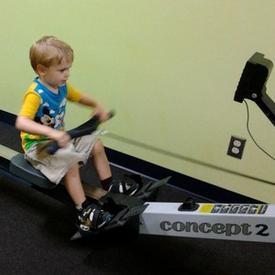HRM's with VO2max stat, improve calorie estimate

heybales
Posts: 18,842 Member
More fun with math Topic!
So those that have Polar HRM's and others that have the visible and changeable personal stat of max HR and VO2max (not the zone setting for an alarm, but on your personal info page along with gender, age, weight, height, max HR, VO2max) have a chance to increase accuracy of calorie burns.
http://www.myfitnesspal.com/topics/show/459580-polar-hrm-calorie-burn-estimate-accuracy-study
Best method for those 2 figures is of course a lab or self test.
http://www.myfitnesspal.com/topics/show/466973-i-want-to-test-for-my-max-heart-rate-vo2-max
And you can make a slight tweak to improve the BMR stat in the HRM too.
http://www.myfitnesspal.com/topics/show/548645-setup-polar-hrm-for-more-accurate-calorie-burn-for-known-bmr
But in researching something else, I discovered a study that came up with a formula that is more accurate than submaximal VO2max tests.
So you could correct that stat and increase accuracy of calories burned.
But my Polar does a resting test for VO2max, why do this? And in above study link, very incorrect for women, might want to confirm anyway what it came up with, it is using this type of method anyway, but using BMI, not bodyfat%, along with resting HR and who knows what else they patented.
First is the max HR stat, which is for almost all Polar's and many other HRM's, and above link is best method, but must be in shape for maximal test. There is included there a submaximal step MHR test that would be good to do before your next workout, and then compare to these different calculated methods, which are better than the 220-age the Polar uses. And if you've ever seen a peak HR higher than any of these in a workout, your max HR is 5 higher at least. Calculator at bottom of the different formula descriptions to compare.
http://www.brianmac.co.uk/maxhr.htm
Second is the VO2max, and again, max HR test with VO2max estimate, or a real lab test, is better than this. But this formula is better than the submaximal tests.
How do I do this, what info do I need?
gender, age, weight, height, bodyfat%, physical activity rating below - calculator, re-reading skills.
Bodyfat% avg can be obtained here. Measure in the morning after hydration levels are normal, read description of locations correctly. 5% range is acceptable for use in this formula. Keep this figure, useful in so many things, like BMR Calc.
http://www.gymgoal.com/dtool_fat.html
Now you need your Physical Activity Rating (PAR). PAR is whole number from 0 to 7.
Select the number that best describes your overall level of physical activity for the previous 6 MONTHS (be honest, but don't short change yourself):
Does not participate regularly in programmed recreation, sport, or physical activity.
0 - Avoids walking or exercise (for example, always uses elevators, drives whenever possible instead of walking).
1 - Walks for pleasure, routinely uses stairs, occasionally exercises sufficiently to cause heavy breathing or perspiration.
Participates regularly in recreation or work requiring modest physical activity (such as golf, horseback riding, calisthenics, gymnastics, table tennis, bowling, weight lifting, or yard work).
2 - 10–60 minutes per week
3 - Over 1 hour per week
Participates regularly in heavy physical exercise (such as running or jogging, swimming, cycling, rowing, skipping rope, running in place) or engages in vigorous aerobic type activity (such as tennis, basketball, or handball).
4 - Runs less than 1 mile per week or spends less than 30 minutes per week in comparable physical activity.
5 - Runs 1–5 miles per week or spends 30–60 minutes per week in comparable physical activity.
6 - Runs 5–10 miles per week or spends 1–3 hours per week in comparable physical activity.
7 - Runs more than 10 miles per week or spends more than 3 hours per week in comparable physical activity.
Now calculate your VO2max figure. BF% is whole number, ie 40% is NOT 0.40, but 40 in formula. Most calculators handle multiply before add/minus correctly, so just go straight across.
BF% VO2max = 50.513 + (1.589 * PAR) – (0.289 * Age) – (0.522 * BF%) + (5.863 * Gender 0 female or 1 male)
The accuracy of the above formula is poor if your real VO2max is 55 or greater, so great reason to actually test and correct if estimate is near that and you are very fit. And my tested 54.0 shows why the formula resulted in 45, accuracy starts going down as you approach 55. So if you ended up at 45 calculated, might be worth doing real test to see if really higher.
So, how does your VO2max figure compare to others and what does it mean?
http://www.brianmac.co.uk/vo2max.htm
So for me, the difference between tested and calculated, for 1hr workout at good HR, that is only a difference of 50 calories. Not huge, but if the only reason you have the HRM is calorie burn estimate, well, there ya go.
What is the potential difference between what your Polar may have estimated, and what you got with formula above? Enter in test workout with both values to compare. Is the difference big enough to you to correct?
http://www.braydenwm.com/calburn.htm
Study. "Appropriate for 96% of the population". "Accuracy ... with all but subjects with VO2peak >= 55 ml/kg/min".
http://www.ncbi.nlm.nih.gov/pubmed/2287267
So those that have Polar HRM's and others that have the visible and changeable personal stat of max HR and VO2max (not the zone setting for an alarm, but on your personal info page along with gender, age, weight, height, max HR, VO2max) have a chance to increase accuracy of calorie burns.
http://www.myfitnesspal.com/topics/show/459580-polar-hrm-calorie-burn-estimate-accuracy-study
Best method for those 2 figures is of course a lab or self test.
http://www.myfitnesspal.com/topics/show/466973-i-want-to-test-for-my-max-heart-rate-vo2-max
And you can make a slight tweak to improve the BMR stat in the HRM too.
http://www.myfitnesspal.com/topics/show/548645-setup-polar-hrm-for-more-accurate-calorie-burn-for-known-bmr
But in researching something else, I discovered a study that came up with a formula that is more accurate than submaximal VO2max tests.
So you could correct that stat and increase accuracy of calories burned.
But my Polar does a resting test for VO2max, why do this? And in above study link, very incorrect for women, might want to confirm anyway what it came up with, it is using this type of method anyway, but using BMI, not bodyfat%, along with resting HR and who knows what else they patented.
First is the max HR stat, which is for almost all Polar's and many other HRM's, and above link is best method, but must be in shape for maximal test. There is included there a submaximal step MHR test that would be good to do before your next workout, and then compare to these different calculated methods, which are better than the 220-age the Polar uses. And if you've ever seen a peak HR higher than any of these in a workout, your max HR is 5 higher at least. Calculator at bottom of the different formula descriptions to compare.
http://www.brianmac.co.uk/maxhr.htm
Second is the VO2max, and again, max HR test with VO2max estimate, or a real lab test, is better than this. But this formula is better than the submaximal tests.
How do I do this, what info do I need?
gender, age, weight, height, bodyfat%, physical activity rating below - calculator, re-reading skills.
Bodyfat% avg can be obtained here. Measure in the morning after hydration levels are normal, read description of locations correctly. 5% range is acceptable for use in this formula. Keep this figure, useful in so many things, like BMR Calc.
http://www.gymgoal.com/dtool_fat.html
Now you need your Physical Activity Rating (PAR). PAR is whole number from 0 to 7.
Select the number that best describes your overall level of physical activity for the previous 6 MONTHS (be honest, but don't short change yourself):
Does not participate regularly in programmed recreation, sport, or physical activity.
0 - Avoids walking or exercise (for example, always uses elevators, drives whenever possible instead of walking).
1 - Walks for pleasure, routinely uses stairs, occasionally exercises sufficiently to cause heavy breathing or perspiration.
Participates regularly in recreation or work requiring modest physical activity (such as golf, horseback riding, calisthenics, gymnastics, table tennis, bowling, weight lifting, or yard work).
2 - 10–60 minutes per week
3 - Over 1 hour per week
Participates regularly in heavy physical exercise (such as running or jogging, swimming, cycling, rowing, skipping rope, running in place) or engages in vigorous aerobic type activity (such as tennis, basketball, or handball).
4 - Runs less than 1 mile per week or spends less than 30 minutes per week in comparable physical activity.
5 - Runs 1–5 miles per week or spends 30–60 minutes per week in comparable physical activity.
6 - Runs 5–10 miles per week or spends 1–3 hours per week in comparable physical activity.
7 - Runs more than 10 miles per week or spends more than 3 hours per week in comparable physical activity.
Now calculate your VO2max figure. BF% is whole number, ie 40% is NOT 0.40, but 40 in formula. Most calculators handle multiply before add/minus correctly, so just go straight across.
BF% VO2max = 50.513 + (1.589 * PAR) – (0.289 * Age) – (0.522 * BF%) + (5.863 * Gender 0 female or 1 male)
The accuracy of the above formula is poor if your real VO2max is 55 or greater, so great reason to actually test and correct if estimate is near that and you are very fit. And my tested 54.0 shows why the formula resulted in 45, accuracy starts going down as you approach 55. So if you ended up at 45 calculated, might be worth doing real test to see if really higher.
So, how does your VO2max figure compare to others and what does it mean?
http://www.brianmac.co.uk/vo2max.htm
So for me, the difference between tested and calculated, for 1hr workout at good HR, that is only a difference of 50 calories. Not huge, but if the only reason you have the HRM is calorie burn estimate, well, there ya go.
What is the potential difference between what your Polar may have estimated, and what you got with formula above? Enter in test workout with both values to compare. Is the difference big enough to you to correct?
http://www.braydenwm.com/calburn.htm
Study. "Appropriate for 96% of the population". "Accuracy ... with all but subjects with VO2peak >= 55 ml/kg/min".
http://www.ncbi.nlm.nih.gov/pubmed/2287267
0
Replies
-
ha bales, i don't know why you write stuff like this, it's too technical for most. When I get super technical no one replies, so i don't do it.
I'm too lazy to read it0 -
poor bales, he needs a hug ((((((((((((((((( bales )))))))))))))))))))
oh, you should see the spreadsheet I'm working on. Everything that has ever come up on MFP normally - but no cell descriptions just input fields and calculations - it should be very interesting.0 -
ha bales, i don't know why you write stuff like this, it's too technical for most. When I get super technical no one replies, so i don't do it.
Very true, it's only for the few that find it important enough, because they are probably training at a level where it matters.0 -
You hit the nail on the head!! Most people just dont know how the vo2max and knowing their HR max can impact the calorie count!!!!
if you want to add my test results in the write up let me know i will email you all the details.0 -
Definitely bumpity for later. I'll read it my Sensei!
 0
0 -
bump0
-
bump0
-
i found that interesting, and had no particular trouble understanding it..... i wonder who it's 'too technical' for?
thanks for a clearly written explanation.0 -
Bump0
-
Thanks for the good info :flowerforyou:
No problems reading or understanding it. But, I'm a techie and a numbers person 0
0 -
I found it interesting. I like the formula to figure my VO2. Must see what my HRM has mine as now and see how they compare.0
-
Yet more reading.0
-
bump0
-
Thanks for taking the time to post this. I used an ft40 then got an f7 - but the calorie burn was much less in the ft7 - I reckoned that as the ft40 did the fitness test it would be more accurate than the ft7 although I did wonder how accurate the vo2max was from the watch calculation. I am using the ft40 at the moment as it means I can track my progress and feel that it should be a bit more accurate, but I don't trust it enough to eat all the calories from it. I am glad that I haven't taken it as gospel I haven't done the test for a few months, so I will try it against a test from your link and see how I go. (although I am still going to use it primarily as a fitness comparison barometer)
cheers0 -
Thanks. I'm going to have to work my way through it. I had done a lab test, and entered the results in my Polar FT60. Since then I've done the fitness test that it recommends, but I've been wondering about accuracy. I'm not a math person, so didn't get this on the first read through, but very much appreciate the information.0
-
Thanks. I'm going to have to work my way through it. I had done a lab test, and entered the results in my Polar FT60. Since then I've done the fitness test that it recommends, but I've been wondering about accuracy. I'm not a math person, so didn't get this on the first read through, but very much appreciate the information.
Oh, if you got lab test of VO2max - use that value.
You would have to do some very specific training to increase it substantially.
And the Polar test, is basically using this same formula, with RHR, and using the BMI method rather than bodyfat% method. Which may be less accurate, may be about the same.0 -
bumping this because I just go the FT80 and don't understand the Vo2max aspect0
-
bumping this because I just go the FT80 and don't understand the Vo2max aspect
if it's the application of this topic, use the spreadsheet referenced in this topic, the HRM tab. Much easier to do and actually compare if needed to change, and does it matter.
http://www.myfitnesspal.com/topics/show/677905-spreadsheet-for-bmr-tdee-deficit-calc-macro-calc-hrm0 -
Thanks. I'm going to have to work my way through it. I had done a lab test, and entered the results in my Polar FT60. Since then I've done the fitness test that it recommends, but I've been wondering about accuracy. I'm not a math person, so didn't get this on the first read through, but very much appreciate the information.
Oh, if you got lab test of VO2max - use that value.
You would have to do some very specific training to increase it substantially.
And the Polar test, is basically using this same formula, with RHR, and using the BMI method rather than bodyfat% method. Which may be less accurate, may be about the same.
I have an FT40 and mine came out exactly the same with the formula vs the HRM. Good to know I guess, though I'm not sure with improved fitness if it would change. It will be interesting to see! Amazing to see some of those athletes numbers on the linked website.
How often to you recommend re-testing VO2 max?0 -
I have an FT40 and mine came out exactly the same with the formula vs the HRM. Good to know I guess, though I'm not sure with improved fitness if it would change. It will be interesting to see! Amazing to see some of those athletes numbers on the linked website.
How often to you recommend re-testing VO2 max?
That's cool confirmation. That also means your bodyfat% is what is avg for your BMI.
It also makes me wonder then if the resting HR even comes into the equation? Oh wait, the long time athlete designation is not a question you answer regarding your workout routine, is it? It must use RHR, if below 60 or something it decides you must be.
Interesting, and thanks for that feedback.
Now study did point out that as your VO2max went up to 50 and above, the formula could no longer keep up.
Firstbeat uses it too, and they provide extra PAR's to go higher in number for more active. But that doesn't really apply either, because you can increase your VO2max going from poor training to good training, even in limited time.
Since VO2max is mostly genetic, and you can only move it somewhat once you get over initial non-working out level, 12-18 months usually decent enough.
What you can train higher, and in shorter time sometimes, is Lactate Threshold. That's actually for performance the more useful figure.
The VO2max is used for better calorie burn estimates, and does explain why your HR may be lower at same pace, but still burning good calories.0
This discussion has been closed.
Categories
- All Categories
- 1.4M Health, Wellness and Goals
- 398.2K Introduce Yourself
- 44.7K Getting Started
- 261K Health and Weight Loss
- 176.4K Food and Nutrition
- 47.7K Recipes
- 233K Fitness and Exercise
- 462 Sleep, Mindfulness and Overall Wellness
- 6.5K Goal: Maintaining Weight
- 8.7K Goal: Gaining Weight and Body Building
- 153.5K Motivation and Support
- 8.4K Challenges
- 1.4K Debate Club
- 96.5K Chit-Chat
- 2.6K Fun and Games
- 4.8K MyFitnessPal Information
- 12 News and Announcements
- 21 MyFitnessPal Academy
- 1.6K Feature Suggestions and Ideas
- 3.2K MyFitnessPal Tech Support Questions








